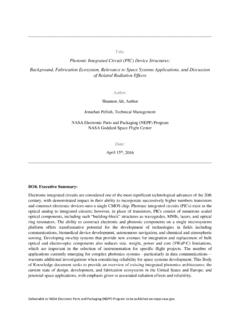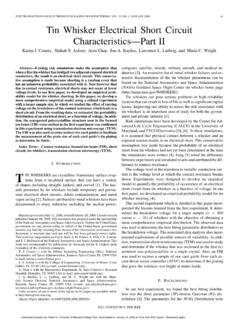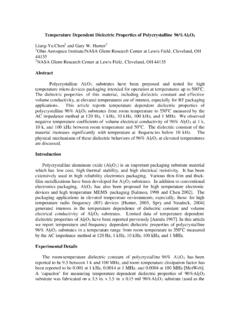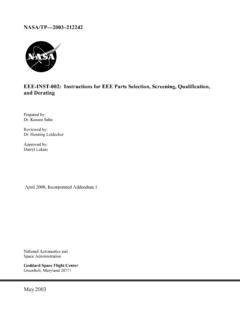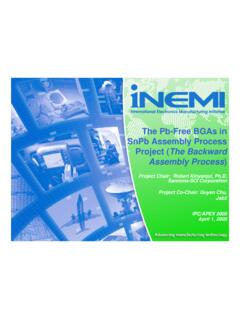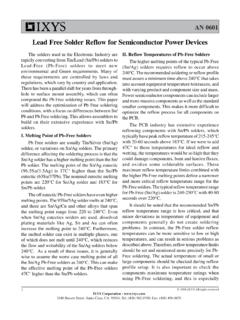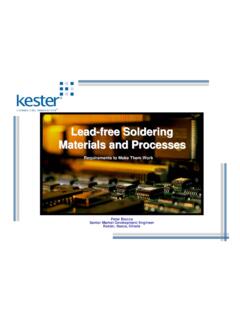Transcription of Mechanical Properties and Microstructure Investigation Of ...
1 Mechanical Properties and Microstructure Investigation Of Lead free solder Qing Wang William F. Gail R. Wayne Johnson Auburn University 162 Broun Hall/ECE Dept. Auburn, AL 36849 334-844-1880 Mark Strickland NASA/MSFC Jim Blanche NASA/MSFC/Allied Aerospace June 24, 2005 Abstract While the electronics industry appears to be focusing on Sn-Ag-Cu as the alloy of choice for lead free electronics assembly, the exact composition varies by geographic region, supplier and user. Add to that dissolved copper and silver from the printed circuit board traces and surface finish, and there can be significant variation in the final solder joint composition.
2 A systematic study of the Mechanical and microstructural Properties of Sn-Ag-Cu alloys with Ag varying from 2wt% to 4wt% and Cu varying from to , was undertaken in this research study. Different sample preparation techniques (water quenched, oil quenched and water quenched followed by reflow) were explored and the resulting Microstructure compared to that of a typical reflowed lead free chip scale package (CSP) solder joint. Tensile Properties (modulus, yield strength and the ultimate tensile strength) and creep behavior of selected alloy compositions ( , , , , ) were determined for three conditions: as-cast; aged for 100 hours at 125oC; and aged for 250 hours at 125oC.
3 There was no significant difference in Young s Modulus as a function of alloy composition. After an initial decrease in modulus after 100 hours at 125oC, there was an insignificant change with further aging. The distribution of strain yield stress and ultimate tensile strength as a function of alloy composition was more significant and decreased with aging time and temperature. The microstructures of these alloys were examined using light and scanning electron microscopy (LM and SEM) respectively and SEM based energy dispersive x-ray spectroscopy (EDS).
4 Fracture surface and cross-section analysis were performed on the specimens after creep testing. The creep testing results and the effect of high temperature aging on Mechanical Properties is presented for the oil quenched samples. In general the Microstructure of oil quenched specimen exhibited a eutectic region of Sn with moderately dispersed Ag3Sn intermetallic, surrounded by a dendritic Sn-rich phase. The SEM images of the fracture surface indicated the presence of a tough shear surface at the initial cavity break area and a break line in the middle of specimen along the failure direction.
5 A hyperbolic-sine creep model was adopted and used to fit the creep experiment data. The effect on the Mechanical Properties of adding the quaternary element bismuth to the alloy was measured and compared with the Mechanical Properties of the ternary alloys. The results of this research study provide necessary data for the modeling of solder joint reliability for a range of Sn-Ag-Cu compositions and a baseline for evaluating the effects of subsequent quaternary additions. CHAPTER 1 Introduction Lead free solders are increasingly used in interconnection systems for electronic packages as a result of pending legislation in the European Union, environmental and health concerns, and market competition.
6 The European Commission s (EC) draft directives, Waste Electrical and Electronic Equipment (WEEE) and Restriction of Hazardous Substances (RoHS), have approved banning the use of lead in electronics in European Union countries effective July 2006. Furthermore, several Japanese electronics manufacturers have successfully created a market differentiation and increased market share based on green products that use Pb- free solders. The conversion to Pb- free solders in the global electronics assembly business appears imminent [1].
7 At present, the industry is in compliance with the existing international legislation (US, Japan, Europe, Australia, Denmark, Sweden), that addresses the environmental and health issues associated with lead. Since the WEEE Directive was issued in 1986, trade and research organizations within the industry have begun to create task forces to research the issues involved in the replacement of lead solder (IPC, EIA, NCMS, NEMI, NIST, PCIF, ITRI). However, so far no viable alternatives have been found that can be used to directly replace the lead bearing solders in all the applications where it is presently used [39].
8 A large number of lead free solder research studies [3-8] have been reported which have focused primarily on microstructural analysis and Mechanical Properties such as Young s modulus, Poisson s ratio, tensile strength, and creep Properties for specified compositions of lead free solders. According to a research report issued by the National Center for Manufacturing Science (NCMS) and the National Electronics Manufacturing Initiative (NEMI), there is no drop in replacement for Sn-Pb eutectic solder at present [5]. Sn-Ag-Cu alloy is considered the preferred substitute for tin- lead solder in reflow applications due to its relatively low melting temperature, and superior Mechanical Properties and solderability compared with other lead free solders.
9 In Japan, the Japan Electronic Industry Development Association (JEIDA) has recommended ; in the EU, the European Consortium - the Industrial and Materials Technologies Program Brite-Euram, recommended ; and in US, NEMI has recommended for reflow soldering and for wave soldering [9]. Research Objectives The NEPP Lead free solder Program research was funded through NASA s Marshall Space Flight Center. The goals of the project were: 1 Develop a new specimen preparation method that will make it possible to characterize Sn-Ag-Cu solder alloy system performance under realistic conditions in electronic packages.
10 Develop a systematic comprehensive database on alloy composition- Microstructure - Mechanical property relationships for Sn-Ag-Cu alloy systems. Investigate the effect on the Mechanical Properties of Sn-Ag-Cu alloys of adding small quantities of quaternary element metals. The work done for this study included process development for a new specimen fabrication technique, tensile and creep testing, an analysis of test data and extraction of the critical parameters from experimental data to fit the constitutive creep model and the prediction of BGA solder joint life by Finite Element Analysis (FEA) modeling based on the above parameters.

